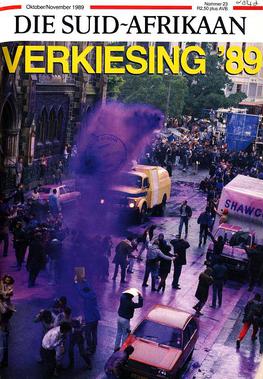
A water cannon is a device that shoots a high-velocity stream of water. Typically, a water cannon can deliver a large volume of water, often over dozens of meters. They are used in firefighting, large vehicle washing, riot control, and mining. Most water cannons fall under the category of a fire monitor.
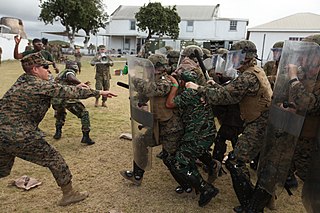
Riot control measures are used by law enforcement, military, paramilitary or security forces to control, disperse, and arrest people who are involved in a riot, unlawful demonstration or unlawful protest.
The following lists events that happened during 1989 in South Africa.

The Hong Kong 1 July protests was an annual protest rally originally held by the Civil Human Rights Front from the day of handover in 1997 on the HKSAR establishment day. However, it was not until 2003 that the march drew large public attention by opposing the legislation of Basic Law Article 23. The 2003 protest, with 500,000 marchers, was the second-largest protest seen in Hong Kong since the 1997 handover.

On 13 September 1989, 30 000 Capetonians from a diverse cross-section of the city marched in support of peace and the end of apartheid. The event, led by Mayor Gordon Oliver, Archbishop Tutu, Rev Frank Chikane, Moulana Farid Esack, Allan Boesak, and other religious leaders, was held in defiance of the State of Emergency. The march resulted in concessions from the apartheid cabinet headed by FW de Klerk, following years of violent clashes between anti-apartheid protestors and the police, and was the first such event to include elected world government functionaries. It was considered the "last illegal march" at the time, and went ahead without a major confrontation. The size of the protest, despite the open defiance, and the restrained response from the police signalled the beginning of the transition to democracy.
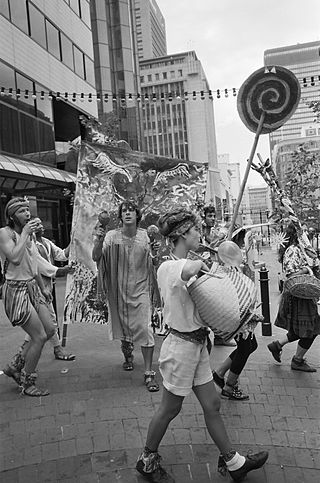
The day after South African State President F. W. De Klerk announced that the African National Congress (ANC) and other political organisations would be unbanned and Nelson Mandela would be released from prison, a small group of Capetonians took to the streets in an act of guerrilla street theatre. The Rainbow Nation Peace Ritual as it eventually came to be known, had been planned ten days before the announcement by the Rainbow People's Party.

Alexander Sinton Secondary School, also known as Alexander Sinton High School, is an English-medium school in Athlone, a suburb of Cape Town, South Africa. The school is located in the Cape Flats, an area designated as non-white under the Group Areas Act during apartheid. The school was involved in the anti-apartheid student uprisings of the 1970s and 1980s. Staff and students at the school made headlines when they barricaded the police into their school in September 1985. The following month, three youths were killed near the school by police officers who opened fire on protesters in the Trojan Horse Incident. It was the first school to be visited by Nelson Mandela after his release from prison. As of 2014, the school has 1,100 pupils, half boys and half girls. The school employs 40 teachers and six non-teaching staff.
Buysile "Billy" Mandindi (1967–2005) was a black South African activist-artist who participated in a landmark protest in Cape Town in 1989, the so-called Purple Rain Protest. Later, still covered with the purple dye that riot police sprayed on protesters, Mandindi created a linocut celebrating the spirit of freedom.

Greenmarket Square is a historical square in the centre of old Cape Town, South Africa. The square was built in 1696, when a burgher watch house was erected.

The Nelson Mandela Mural is a 10-storey, 2,174 square feet (202.0 m2) public artwork on Juta Street in Braamfontein, Johannesburg, created by Shepard Fairey and completed in September 2014. It pays tribute to Nelson Mandela and the 25th anniversary of the Purple Rain Protest. The mural overlooks the Nelson Mandela Bridge, and is seen by many as a sequel to Fairey's iconic Barack Obama HOPE poster.

#FeesMustFall was a student-led protest movement that began in mid-October 2015 in South Africa. The goals of the movement were to stop increases in student fees as well as to increase government funding of universities. Protests started at the University of Witwatersrand and spread to the University of Cape Town and Rhodes University before rapidly spreading to other universities across the country. Although initially enjoying significant public support the protest movement started to lose public sympathy when the protests started turning violent.

On November 10, 2016, three days of protests in Portland, Oregon, turned into a riot, when a group of anarchists broke off from a larger group of peaceful protesters who were opposed to the election of Donald Trump as president of the United States.

In October 2019, the 2019–2020 Hong Kong protests saw a further escalation of violence. It became evident that the protests were unlikely to end soon, and that they posed the biggest popular challenge to Chinese Communist Party (CCP) leader Xi Jinping since his ascension to CCP general secretary in 2012. To bring the situation under control, Chief Executive Carrie Lam invoked colonial-era powers to impose an anti-mask law, aimed at preventing protesters from hiding their identity. Observers considered the law, which came into force on 4 October, as a precedent for possible wider use of emergency powers at the expense of citizens' freedoms and in addition democratic rights, as they even saw the possibility of the upcoming District Council elections being cancelled based on the emergency law. The mask ban did, however, not achieve the desired effect, but rather proved a further focal point of protests. In November, the High Court ruled the mask ban to be unconstitutional, although in April 2020, an Appeal Court ruled that it was constitutional in the case of unlawful assemblies.

The Greenmarket Square refugee sit-in was a sit-in protest by a group of refugees for the purpose of getting relocated to a country outside of South Africa in response to xenophobia in the country. It lasted from 8 October 2019 when protestors first occupied the Waldorf Arcade to 2 April 2020 when the last group of protestors were evicted from the Central Methodist Mission church. The protestors demanded that UNHCR assist them with being relocated to a third country outside of South Africa and other than their country of origin. At its height the protest grew to include about 624 protestors, including 65 undocumented refugees, according to a lawyer for the South African Department of Home Affairs.

The George Floyd protests were a series of protests and civil disturbances that initially started in the Minneapolis–Saint Paul metropolitan area of Minnesota, United States, before spreading nationwide. In Columbus, Ohio, unrest began on May 28, 2020, two days after incidents began in Minneapolis. The events were a reaction to the murder of George Floyd by Minneapolis Police Department (MPD) officer Derek Chauvin, who knelt on Floyd's neck for over nine minutes, asphyxiating him.
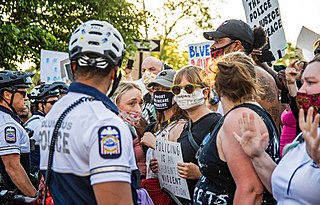
Beginning on May 28, 2020, a number of cities in Ohio saw protests against the murder of George Floyd. Major cities such as Columbus, Cleveland, Cincinnati and Dayton had large protests, and numerous smaller cities and towns saw demonstrations as well. As a result of rioting and looting, a number of cities such as Cleveland, Columbus, Dayton, Cincinnati and Springfield imposed curfews of varying times.

The George Floyd protests and riots in Philadelphia were a series of protests and riots occurring in the City of Philadelphia. Unrest in the city began as a response to the murder of George Floyd in police custody in Minneapolis on May 25, 2020. Numerous protests, rallies and marches took place in Philadelphia in solidarity with protestors in Minneapolis and across the United States. These demonstrations call for justice for Floyd and protest police brutality. After several days of protests and riots, Philadelphia leadership joined other major cities, including Chicago in instituting a curfew, beginning Saturday, May 30, at 8 p.m. The protests concluded on June 23, 2020.
This is a list of George Floyd protests in the U.S. state of Missouri.
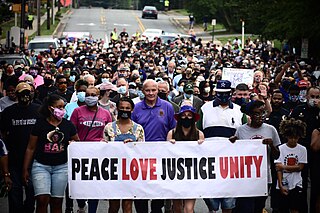
This is a list of George Floyd protests in North Carolina, United States.

The Central Methodist Church, also known as the Central Methodist Mission or Metropolitan Methodist Church, is a large and historically important Methodist church located on Greenmarket Square in Cape Town, South Africa. The church has played a significant role in the growth of Methodism in South Africa. In 1988, the Metropolitan Church merged with Buitenkant Street Church, forming the Central Methodist Mission.
